Customer service teams are increasingly turning to chatbots to help scale support, deflect repetitive inquiries, and free up human agents to focus on more complex tasks. But with so many AI solutions available, choosing the right one can feel overwhelming.
In this guide, we’ll walk through what customer service chatbots are, how modern tools differ from earlier versions, and which features actually matter when selecting the right chatbot for your team. Then, we'll take a look at the 10 best chatbots for customer service teams.
What is a customer service chatbot?
A customer service chatbot is a digital assistant designed to simulate human-like conversations and resolve customer inquiries, typically through a website, in-app widget, or messaging platform. These bots can either use simple logic flows (rule-based) or leverage artificial intelligence to interpret customer intent and provide relevant answers.
If you’ve interacted with any customer service teams recently, you’ve likely used a chatbot as a starting point for your experience. There are many great chatbot examples out there, and while they all tackle similar problems, they can take different forms and create vastly different customer experiences.
AI chatbots vs. rule-based chatbots
Traditional rule-based chatbots operate like decision trees. They follow predefined scripts and can only respond accurately when the customer’s query fits neatly within expected parameters. These bots often break down when users go off script or ask multi-intent questions.
In more basic cases, they also do not allow customers to type at all, only going through predefined paths. These one-way-through experiences can lock customers into a single line of questioning. If you’ve ever helped a customer before, you know customer service is rarely that simple.
AI chatbots, on the other hand, leverage natural language processing (NLP) and machine learning to understand context and intent. They draw on your existing data — like FAQs, help center content, and past support tickets — to provide more human-like responses to customers. They also improve their accuracy over time based on customer interactions.
The result is more human-like and helpful support, without relying on rigid logic paths.
I work at AIHR, where we used a rule-based chatbot flow for two years. While it supported our teams with handling many of the general questions from our customers, it ended up being quite rigid and one-way, often creating unintended friction.
We've recently made the change to using Help Scout’s AI Answers (more on this below), because we believe it will allow for our customers to have much more dynamic and organic conversations solving their problems — not just the problems we think they’re most likely to have.
The benefits of using chatbots for customer service
Using chatbots for customer service can enhance the support experience. Whether it’s faster responses, 24/7 availability, or reduced workloads for your team, the right chatbot can play a key role in scaling service without sacrificing quality. Using a chatbot can:
Reduce response times and increase resolution speed.
Deflect repetitive or low-complexity queries.
Free up support agents for high-impact conversations.
Provide 24/7 support coverage, even outside business hours.
Scale support operations without proportionally increasing headcount.
Improve consistency in messaging and tone.
These are high-level benefits, and there are plenty more benefits of using a chatbot in your service experience. The key thing to remember is that none of these benefits come automatically. In order to see these chatbot benefits in your business, you need to find the right chatbot solution, implement it thoughtfully, and continually work to make it better.
Key features to look for in a customer service chatbot
There are a ton of chatbot platforms to choose from, so it’s important to separate the must-have features from the nice-to-haves. Here are the core capabilities to prioritize when evaluating tools for your team.
Natural language understanding and intent detection: You need the chatbot to be able to understand exactly what your customers are looking for.
Ability to integrate with your knowledge base and support stack: This way, your chatbot can easily be trained and stay current on feature changes, product improvements, and more.
Human handoff for complex or escalated issues: Chatbots are great with low-complexity issues, but it should always be easy for your customers to get human support when they need it.
Multi-language support for global teams: If you serve customers from around the world, your chatbot should be able to understand questions in any language.
Conversation logs and analytics: Getting a chatbot without logs and analytics is risky, because you need to understand how it’s performing and where it can get better. Analytics help you gain insight to make improvements and maintain your standard of excellence.
Low-code or no-code setup and maintenance: Most support teams don’t have the resources, time, or skillset to write code and implement a complex, engineering-heavy solution themselves. A no-code or low-code solution makes it easier to get started and frees you up to focus on your customers.
Transparent pricing and scalability. With the major improvements in generative AI over the last few years, many chatbot and AI platforms are experimenting with different pricing models. Don’t get blindsided by unexpected or unpredictable costs — find a provider with transparent and easy-to-understand pricing.
An effective chatbot implementation can have a huge impact on your customer experience and your support team’s workload, and it’s important to get the right fit for you and your customers.
The 10 best chatbots for customer service in 2025
Each of the tools below has been selected for its unique approach to solving customer service challenges, whether that's through AI-powered deflection, no-code setup, or deep integrations with your existing stack. While some tools are built for rapid deployment and SMB needs, others offer enterprise-grade scalability.
Regardless of your team size or technical bandwidth, you're likely to find a solution that aligns with your support goals in one of the best customer service chatbots below.
1. Help Scout
Best combined help desk and customer service chatbot.
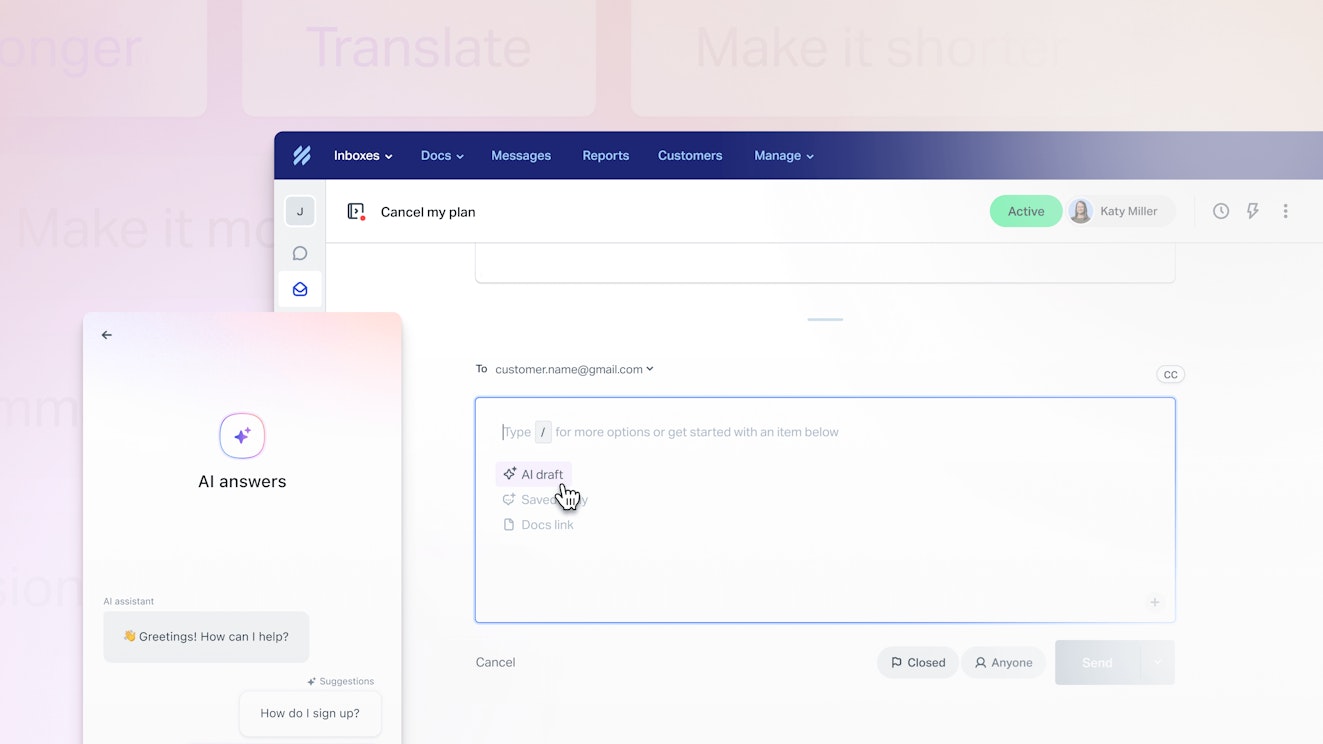
Help Scout’s AI features are thoughtfully designed to improve agent productivity while preserving the human element in your customer support. At Help Scout, the future is still customer-first.
Beacon — Help Scout’s messaging tool — works seamlessly with its AI Answers feature, allowing customers to ask questions and get natural-language responses based on content from sources like your knowledge base or company website (no flow-building required). AI Answers is integrated into your existing service experience, making implementation much easier than using a third-party tool.
Ease of implementation is something that Help Scout brings into the entire suite of tools that they offer. I’ve been a long-time customer of theirs myself at AIHR (four years at the time of writing this article), and we were able to support a growing customer base from 8,000 users to 23,000 users without a hassle.
Our success at AIHR came down to the simplicity of features like workflows, which helped automate and scale how we handle multiple channels of communication in our shared inboxes. Unlike other tools, workflows are simple and easy to learn for anyone who needs to scale a team in the Help Scout environment.
It’s this ease of use — common across the whole Help Scout platform — that recently allowed us to roll out AI Answers at speed, where it would have taken a lot more time, energy, and budget to implement a third party tool.
Key features
AI Answers: Use your knowledge base and external website content to provide instant, accurate responses to common questions from your Beacon, freeing up valuable time for the human touch where it matters most.
AI Drafts: Create draft responses to customer requests based on information from previous conversations and your knowledge base articles.
AI Summarize: Summarize long conversations with a single click.
AI Assist: Correct spelling and grammar mistakes, alter the tone or length of a reply, or translate a reply into another language.
Pricing
Free plan and trial available. View Help Scout's current pricing.
2. My AskAI
Best for small teams that want fast, low-lift AI support agents trained on internal content.
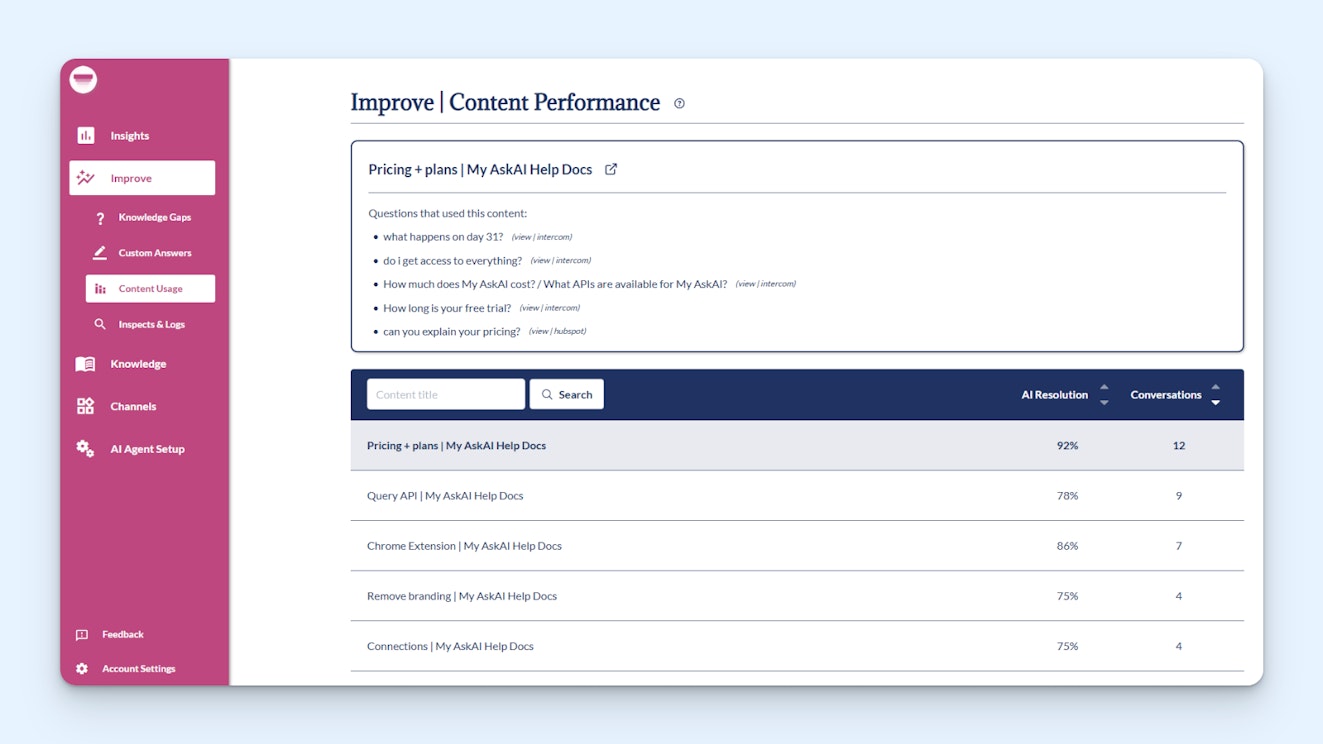
My AskAI helps support teams deliver instant answers using their own internal knowledge sources. You upload documents, help articles, or links to your site, and the tool generates a custom AI agent trained to respond using that data. It’s particularly appealing for small teams that want to enhance support within an existing setup rather than adopt an entirely new support suite.
With flexibility in how you can implement and use the AI agent by My AskAI, you can choose exactly how you would like to use AI in your workflows. This allows you to be more intentional about how you roll things out.
Specifically, you can choose to have the AI Agent respond to customers directly or pre-emptively draft responses for your team, acting as a co-pilot. If a customer asks to speak with a human, it immediately tags and escalates the conversation where your team can leverage in-email drafts also supported by My AskAI.
Not only do they support customers, but it also supports internal teams. While the bot is interacting in your environment, it will also identify knowledge gaps and compile them so you can update your knowledge base to make your experience even better.
Key features
Chatbot and email assistant: Use your AI assistant's knowledge to automatically respond to your support contacts. Users can still contact a human if the assistant can't answer.
Improve: The answer improvement studio will show you all the questions that your AI was unable to answer that resulted in a handover to a person.
Custom answers: Add “knowledge snippets” to your AI agent directly in My AskAI to resolve knowledge gaps. Track usage of which pieces of knowledge have been used to answer questions most frequently and how often they result in an AI resolution.
Localization: Change the language of your AI support agent to the language your customers speak.
Smart suggestions: Use AI to analyze the questions your users are asking to generate ideas of how you could resolve or fix the topic to make sure it doesn't come up as an issue again.
Pricing
Free trial available. View My AskAI's current pricing.
3. Wonderchat
Best for businesses needing transparent AI answers with source citations and smart human escalation.
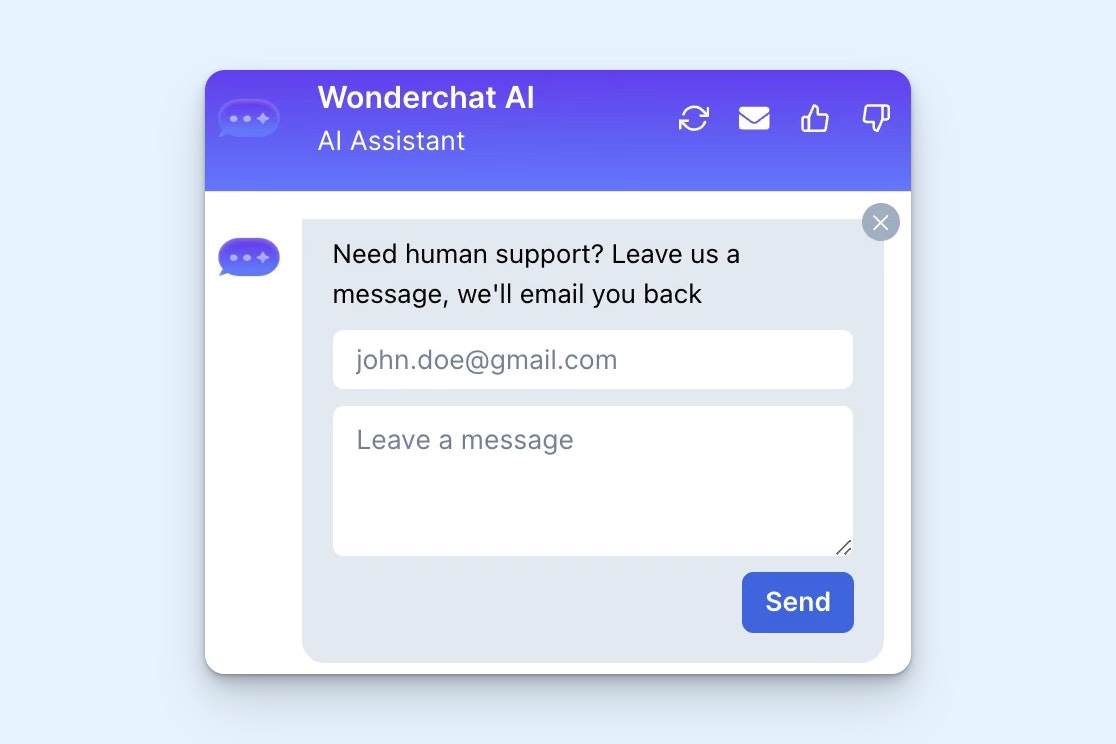
Wonderchat uses GPT-based responses to quickly address customer queries with answers pulled from your website or uploaded content. Unlike many plug-and-play AI tools, Wonderchat includes source citation in its responses and offers live agent handoff when automation hits a wall, making it a practical and transparent solution for small and growing teams.
Wonderchat focuses on being able to implement AI assistants at speed while still maintaining the robust training and tuning capabilities needed to make a great customer experience.
Key features
Share links or upload files: Train AI on data from sitelinks, YouTube links, or uploaded files to build a chatbot from your knowledge base, keeping your chatbot responses tailored and specific.
Build and customize with speed: Once trained, customize your chatbot's tone and style, and write custom instructions to give your chatbot a personality. Chatbots are typically ready for use within five minutes.
Smart routing to email support or live chat: Let your AI chatbot call in a human if it can't answer all of your customer’s queries. Your support agents can reply to the question straight from their inbox or from Wonderchat’s live chat interface.
Train your chatbot for improved performance over time: Don't like a response your chatbot is giving? Train your chatbot to learn from its mistakes by providing a model answer. Your customers can also leave feedback on the bot’s performance to help with the fine-tuning process.
Conversation reports and analytics: Your AI chatbot reports to you daily, summarizing its key conversation topics and any new leads collected. Monitor the quality of user conversations and review advanced AI summaries and topic classifications.
Pricing
Free trial available. View Wonderchat's current pricing.
4. LetsAsk.AI
Best for multilingual teams looking to deploy content-trained chatbots across global audiences.
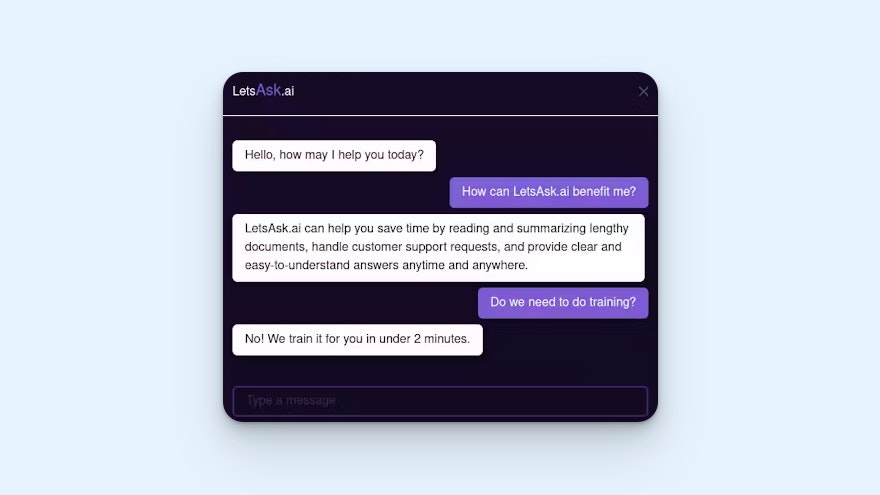
LetsAsk.AI allows businesses to deploy ChatGPT-style bots trained on their own content, with the added bonus of multilingual support out of the box. Whether you’re working across geographies or supporting diverse audiences, this tool helps you answer questions clearly and contextually in your customers’ preferred language.
LetsAsk.AI is looking bold while keeping things simple. What differentiates LetsAsk.AI is their focus on privacy and security, promising military-grade encryption, GDPR compliance, and access control.
Key features
Easy chatbot creation: Create chatbots by simply linking, typing, or uploading your content and defining your voice and tone. When the bot is created, it immediately gives you the embed code, so you can get things rolling quickly.
Multilingual support: Add content and ask questions in 95 different languages so that you can create and help in the language that works best for you and your customers.
High-grade security and privacy: After processing, your files are deleted, and only the raw text is stored in an isolated container with military-grade encryption (AES-256). LetsAsk.AI also adheres to the core principles of GDPR regulations, ensuring that you have complete control over your data and who has access to it.
Integrations: Get support where you need it most by integrating with Discord, Slack, and Zapier to expand reach and workflows.
Pricing
No free trial offered. View LetsAsk.AI's current pricing.
5. Automatic Chat
Best for founders and small businesses who need a no-fuss chatbot launched from a URL.
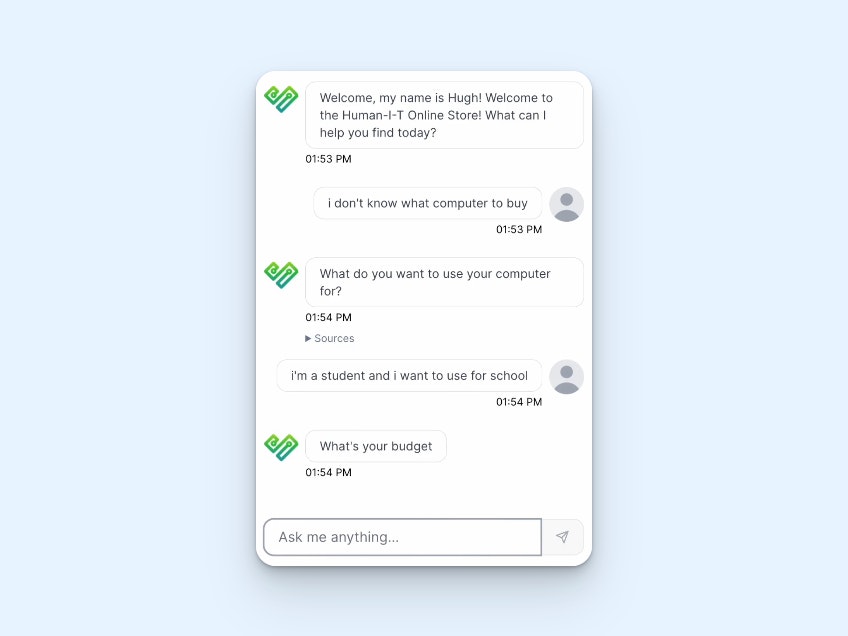
Automatic Chat is all about speed and simplicity. In just seconds, you can create a chatbot trained on your website content — no technical expertise required. It's particularly useful for solo founders, ecommerce teams, and lean support setups that need simple automation without complexity.
One of the big things to note here is that Automatic Chat has a wide variety of potential sources that give you input, meaning if you are using Notion, Google Docs, or (almost) anything else for your documentation, you can build a bot quickly and with flexibility.
Key features
Train on anything: Your chatbot can learn from your website, PDFs, Google Docs, Notion, and more.
Detailed chat history: You can see user information including device type, location, and much more, providing granular details into their setup and how it may impact their experience with the bot.
Inspect: With Inspect, you can see the nitty gritty details, even down to the code running behind the bot at the time. As someone who really wants to see the technical, behind-the-scenes details, it was great to see the option to fully debug the bot.
Reporting: Automatic Chat also offers clean and simple out-of-the-box reporting.
Pricing
Free trial and plan available. View Automatic Chat's current pricing.
6. Wotnot
Best for customer support teams needing flexible, no-code chatbot flows with live chat built-in.

Wotnot is a visual chatbot builder designed for teams that want customization without writing code. It works across industries — from ecommerce to real estate — and includes built-in live chat, lead generation workflows, and CRM integrations. It’s ideal for businesses with unique processes and customer journeys.
Unlike some of the other “load and launch” chatbot services, Wotnot stands out because of its logic-tree and agentic capabilities. This means that it’s not just a chatbot, as you also have the flexibility to blend in live chat and agent capabilities.
Key features
Drag-and-drop workflow builder: Make the bot as simple or as complex as you’d like with a blank canvas or pre-built templates for common use cases. Great for those already familiar with visual workflow builders.
CRM Integrations: Update and retrieve data directly from your CRM, giving your chatbot the information it needs to truly know your customers.
Native WhatsApp and SMS interactions: Meet your customers where they are and build a chatbot that interacts via the WhatsApp interface or text message. This works great for inbound and outbound interactions, keeping customers up to date regardless of their preferred communication channel.
Robust reporting: Given that you can report on chat interactions as well as leads and revenue generation, this is a great tool for both customer service and marketing teams.
Pricing
Free trial available. View Wotnot's current pricing.
7. Intercom Fin
Best for Intercom, Zendesk, or Salesforce customers looking to scale AI-first support.
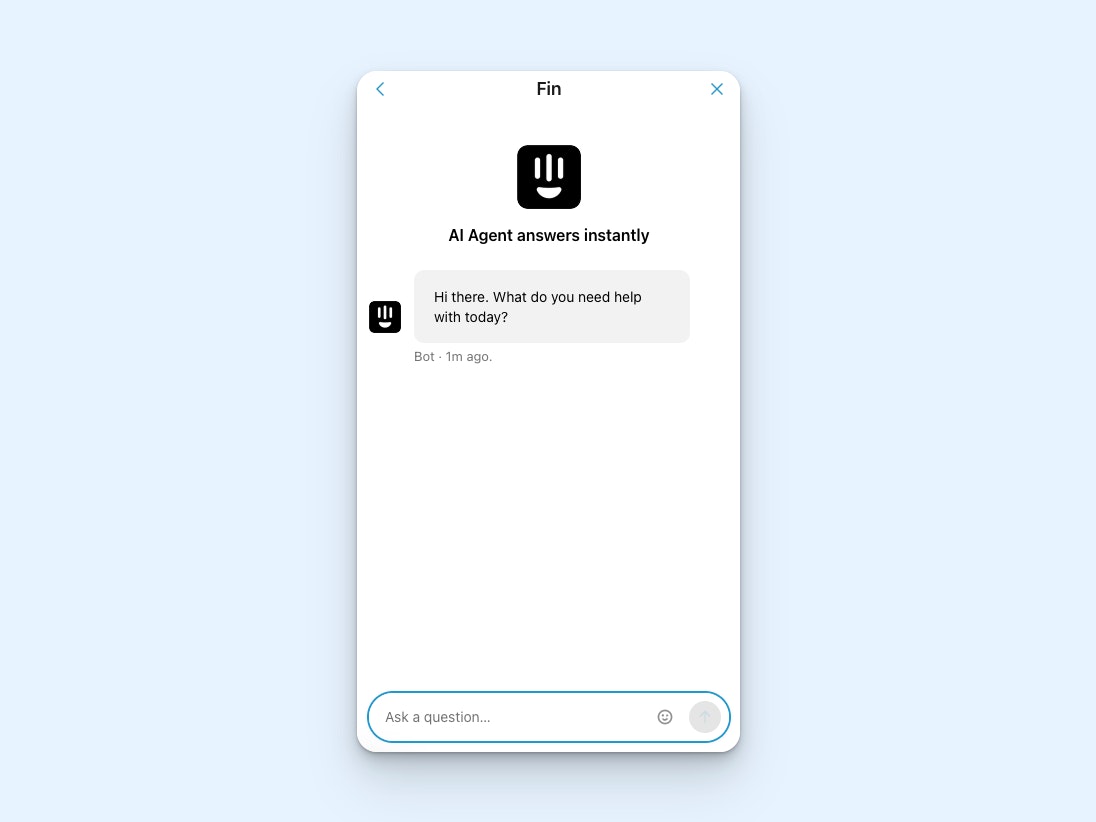
Intercom’s Fin is designed for high-growth teams looking to reduce ticket volume and increase deflection rates without sacrificing quality. Built into the broader Intercom platform, Fin leverages GPT-4 to answer questions in real time using your help content, and it escalates seamlessly when human intervention is required.
As Intercom goes all in on Fin, they have expanded the service off of Intercom. Fin was originally only available on Intercom’s platform, but now it also works for Zendesk and Salesforce Service Cloud customers, too.
Key features
Knowledge: Fin AI Agent can generate accurate answers by instantly learning everything about your company, products, and processes from your existing knowledge sources.
Behavior: Fin is reliable, speaks 45 languages in your tone of voice, and follows your policies and procedures to consistently deliver the best possible customer experience.
Actions: Fin personalizes its service for every customer wherever they are, taking actions on their behalf and adjusting quickly to serve their unique needs.
Insights: AI-generated insights help you identify which topics drive dissatisfaction, what knowledge Fin is missing, and what actions to set up next to improve quality and performance.
Pricing
Free trial available. View current pricing for Fin.
8. Ada
Best for enterprise CX teams needing powerful automation and personalized support at scale.
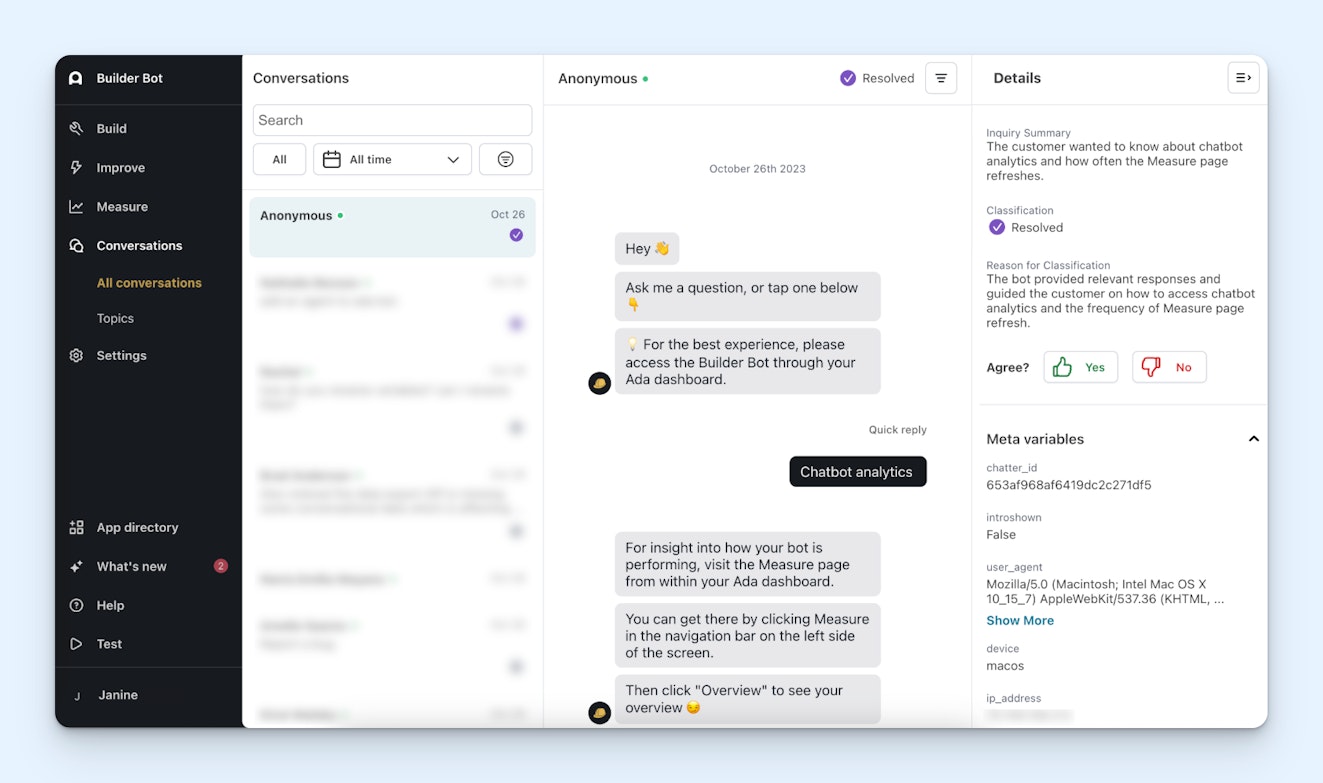
Ada helps large teams deliver personalized, on-brand support experiences at scale. Its intuitive builder allows support and CX teams to automate repetitive questions, recommend actions, and integrate seamlessly with backend systems, all without engineering help.
Ada’s original product was essentially a rules-based chatbot, but over the last few years that functionality has been complemented by the launch of an AI-powered chatbot experience.
Key features
AI voice support: Extend your customer service capabilities with AI-powered voice interactions, allowing customers to engage through natural, conversational speech.
Private testing and coaching: Utilize private testing environments to refine your AI agent's performance, and leverage coaching tools to continuously improve response accuracy and effectiveness.
Advanced no-code workflow builder: Design and deploy complex support workflows without any coding, enabling rapid customization to meet evolving customer needs.
Multichannel support: Engage customers seamlessly across various platforms, including web, mobile, and messaging apps, ensuring consistent support experiences.
Real-time analytics and A/B testing: Monitor your AI agent's performance with real-time analytics, and optimize interactions through A/B testing to enhance customer satisfaction.
Pricing
No free trial offered. Contact Ada for pricing.
9. Forethought
Best for AI-native teams looking to streamline ticket resolution and triage across the support lifecycle.
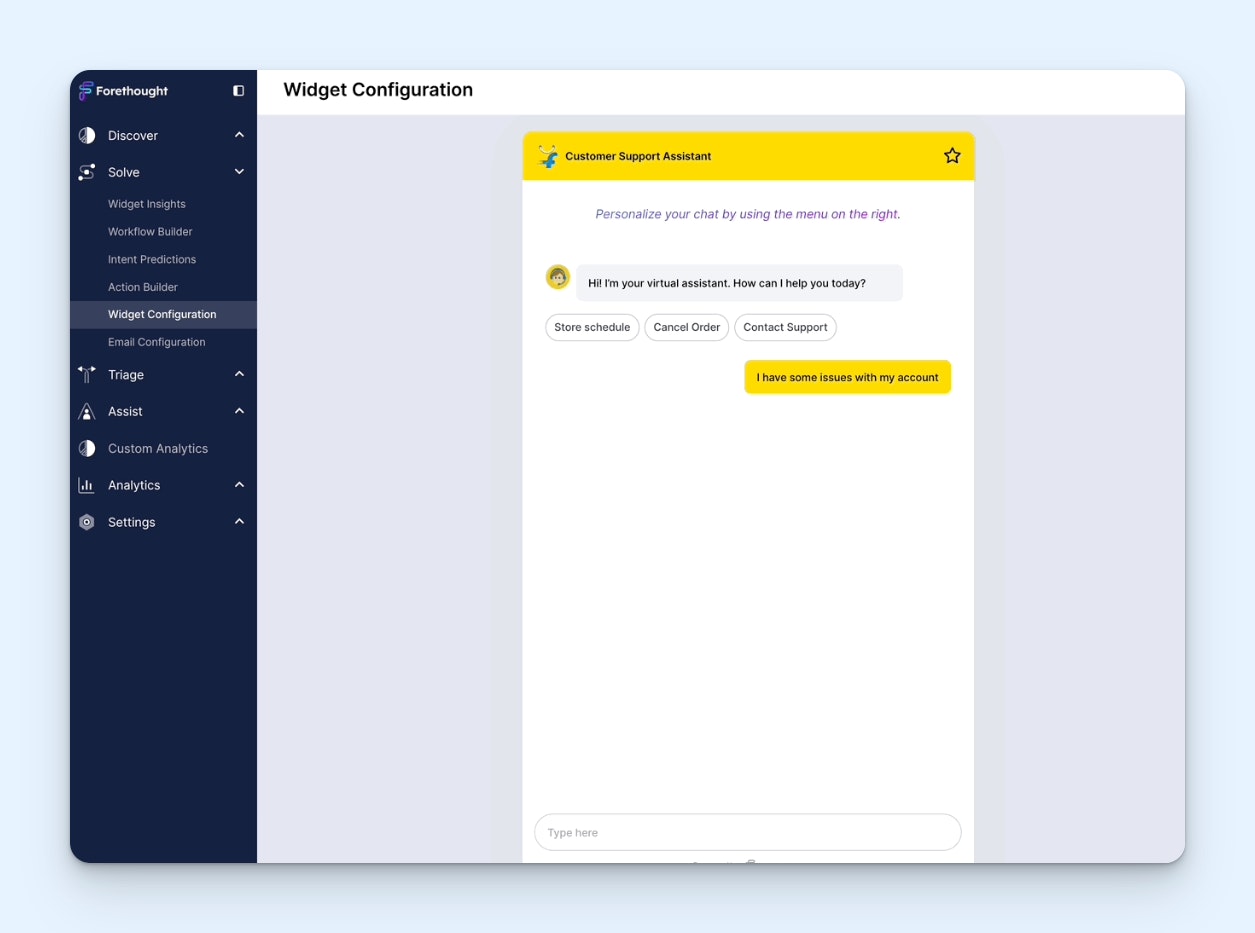
Forethought is a full AI platform designed to embed intelligence at every layer of the support experience, from deflecting tickets before they hit the inbox, to predicting intent, to drafting agent replies. Forethought focuses on reducing time to resolution without compromising on quality.
At the core is SupportGPT™, which can handle customer questions using your historical tickets, help center content, and CRM data. Where Forethought really stands out is in the background with tools that improve triage, assist agents mid-ticket, and identify content gaps across your team’s support ops. This is great for teams looking to leverage AI, even if it’s not for a customer-facing solution.
For teams that are already thinking beyond “bot-first” and are ready to reimagine how AI shapes internal workflows too, Forethought brings that end-to-end view.
Key features
SupportGPT™: Trained on your historical support content, it automatically resolves common requests with high-quality responses.
Triage: Automatically prioritize, tag, and route incoming tickets based on intent and urgency, saving your team from manual sorting.
Assist: Offer in-the-moment suggestions and reply drafts for agents working through more complex conversations.
Solve: Surface deflection insights so you can understand what’s working, what’s escalating, and where to improve.
Out-of-the-box integrations: Plug in with platforms like Salesforce, Zendesk, and Freshdesk with minimal lift.
Pricing
No free trial offered. Contact Forethought for pricing.
10. Sendbird
Best for product-led companies building in-app messaging with AI chatbot support.
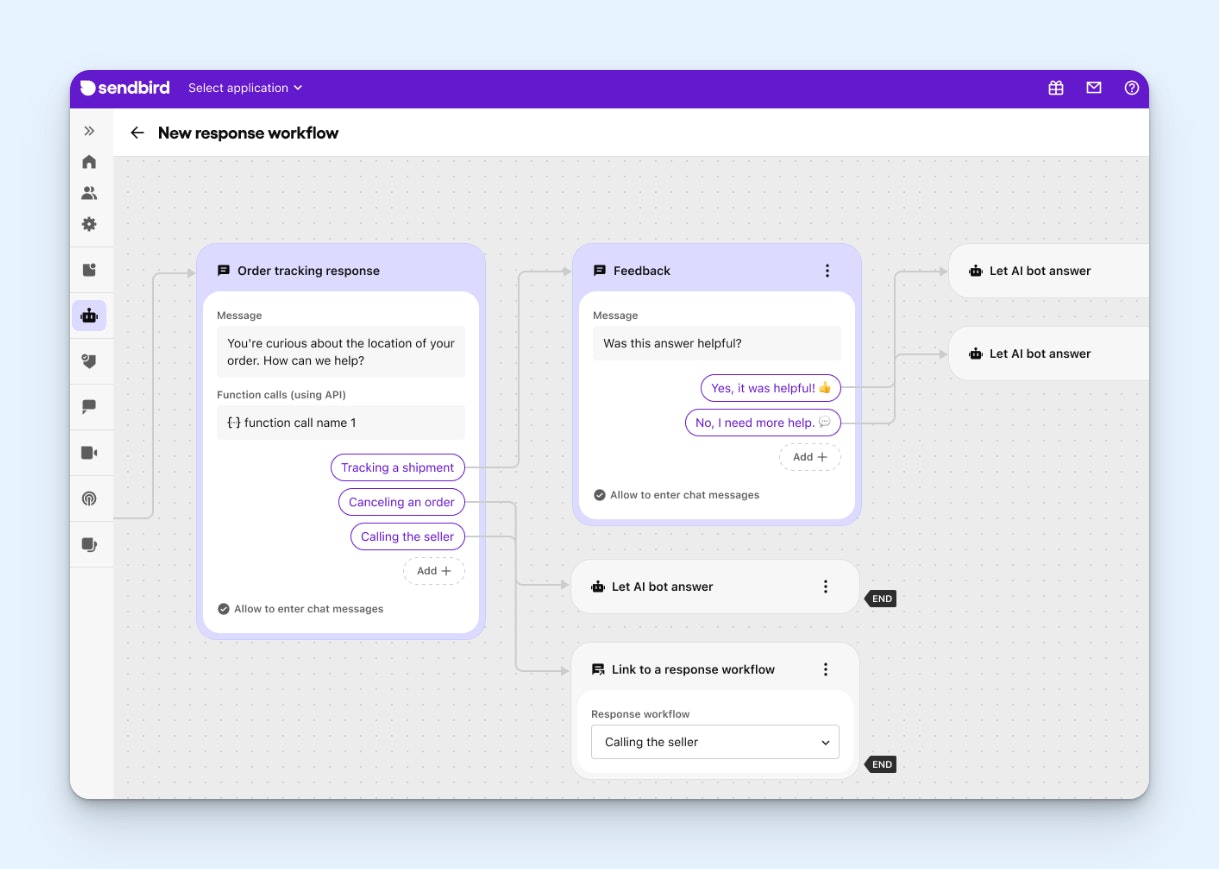
Sendbird isn’t a plug-and-play chatbot. It’s a developer-first platform built for companies that want total control over the in-app messaging experience with AI layered in to streamline conversations, automate FAQs, and guide users through onboarding or transactional flows.
With a rich set of APIs and SDKs, you can embed AI-powered chat into your product from day one, complete with smart routing to live agents when needed. It’s especially well-suited for apps where messaging is core to the user experience.
If you’re building support directly into your product and want to do it your way, Sendbird gives you a foundation with technical flexibility.
Key features
AI chatbot integration: Add conversational automation to your in-app chat with seamless fallback to human agents when questions get complex.
Web and mobile SDKs: Quickly embed chat into iOS, Android, and web apps with out-of-the-box UI kits and custom styling options.
Conversational workflows: Automate onboarding, transactional updates, or FAQs with logic-driven flows built into your product.
Developer flexibility: Build exactly what you need with granular API access and full front-end customization.
Secure and scalable: Enterprise-ready infrastructure with encryption, compliance, and global data delivery built in.
Pricing
No free trial offered. Contact Sendbird for pricing.
Choosing the right chatbot for your customer support team
The right chatbot isn’t just about AI bells and whistles, and it’s not just about deflecting tickets to minimize costs. It’s about how well the tool fits into your team’s workflows, your customers’ expectations, and the broader support ecosystem.
Here are some questions to ask as you explore chatbot solutions:
Will this integrate cleanly with your existing help desk?
Does it reduce complexity for your team?
Can you trust the AI to provide accurate and effective responses?
Is the handoff to human support accessible and easy?
How much time or technical skill is required to implement or maintain it?
Whether you're scaling a support team or just looking to ease your frontline load, customer service chatbots can make your team faster, more consistent, and more available without losing the personal touch.







